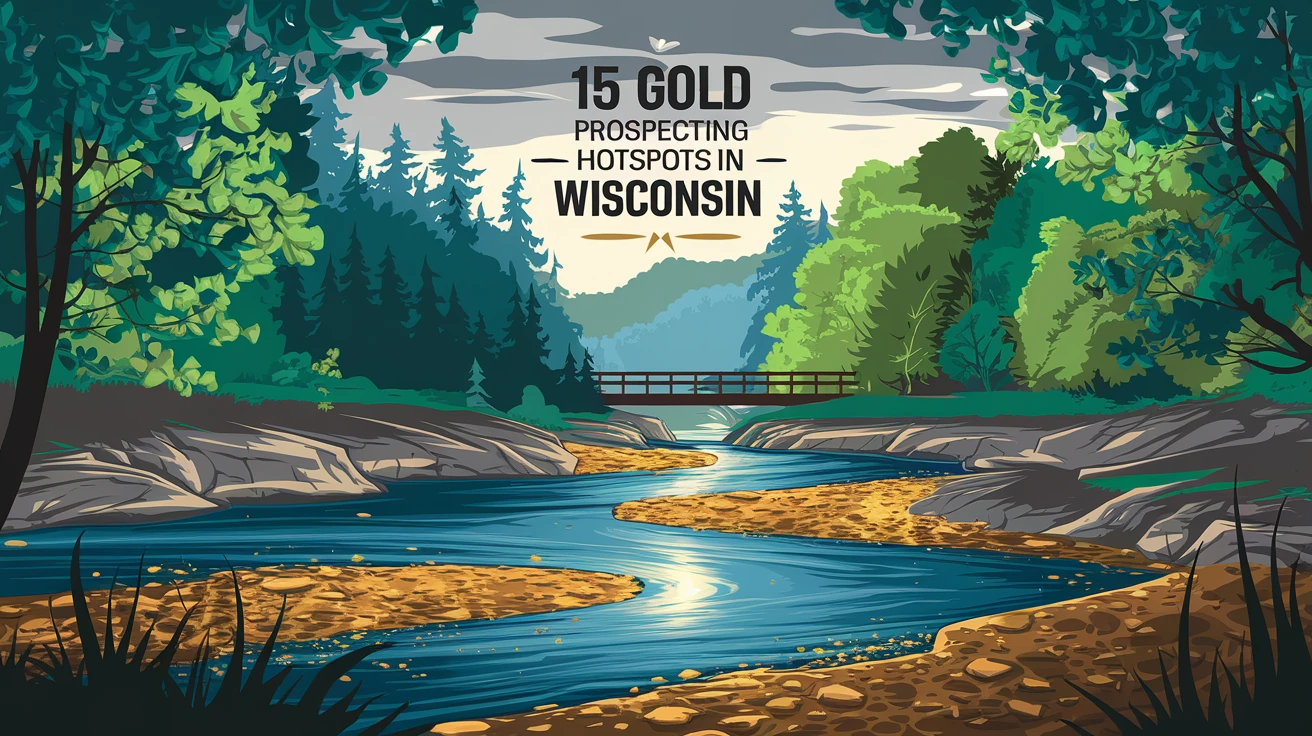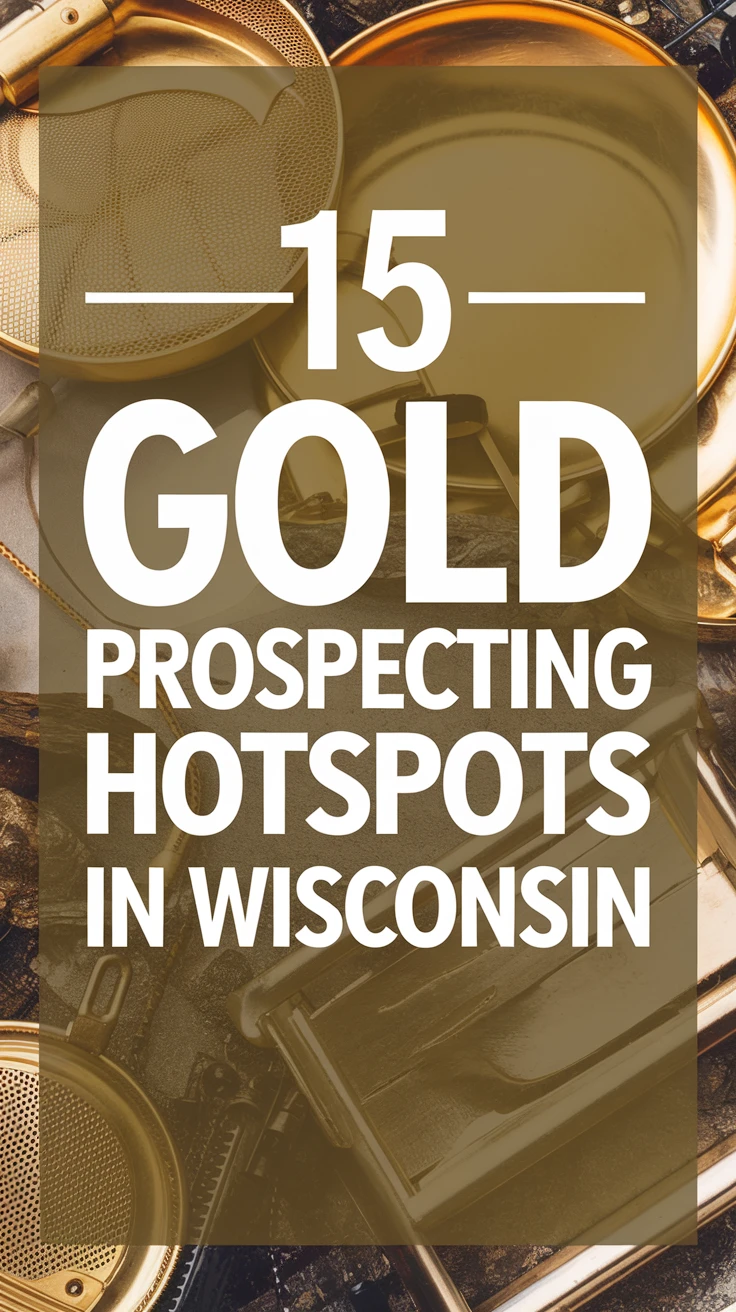
For many outdoor enthusiasts and treasure hunters, the idea of finding gold in Wisconsin might seem far-fetched. However, the Badger State holds numerous hidden opportunities for prospectors willing to put in the time and effort. While Wisconsin isn’t typically associated with major gold rushes like California or Alaska, its glacial deposits and ancient river systems have scattered fine placer gold throughout the state. This comprehensive guide will take you through 15 promising locations where you can try your luck at gold prospecting in Wisconsin, along with essential tips and techniques to maximize your chances of success.
Understanding Wisconsin’s Gold History
Most of Wisconsin’s gold deposits resulted from glacial activity during the last ice age. As massive glaciers moved southward from Canada, they carried gold-bearing rock and sediment, depositing them across the state. While you won’t find massive nuggets here, patient prospectors can discover fine flour gold and occasional small flakes in various locations.
Types of Gold Found in Wisconsin
- Placer Gold: Small flakes and flour gold in stream beds
- Glacial Gold: Deposited by ancient glaciers
- Black Sand Deposits: Often associated with fine gold
- Quaternary Deposits: Recent geological formations containing gold
Essential Equipment for Wisconsin Gold Hunting
Before heading out to any of our recommended locations, ensure you have the right tools for the job.
| Basic Equipment | Purpose | Estimated Cost |
|---|---|---|
| Gold Pan | Primary tool for separating gold from sediment | $10-20 |
| Sluice Box | Process larger amounts of material | $50-100 |
| Classifier Screens | Sort material by size | $20-30 |
| Shovel | Dig and collect material | $15-25 |
15 Prime Gold Prospecting Locations
1. Plum Creek
Located in Pierce County, Plum Creek has historically yielded fine placer gold. The best access point is near the intersection of Highway 10 and County Road O. Focus on searching the inside bends and behind large boulders where gold tends to accumulate.
2. Wisconsin River – Prairie du Sac
This location offers excellent opportunities for gold panning, especially after spring floods. The sandbars downstream from the dam are known hunting grounds for local prospectors.
3. Black River Falls
The Black River area has a rich history of gold discoveries. Focus on the stretch between Black River Falls and La Crosse, particularly in areas with exposed bedrock.
4. Eau Claire River
Known for its glacial deposits, the Eau Claire River contains fine gold, especially near its confluence with the Chippewa River.
5. Rock River
The Rock River, particularly near Jefferson, has produced finds of flour gold. Look for areas with natural sluices in the bedrock.
| Location | Best Season | Gold Type |
|---|---|---|
| Plum Creek | Late Spring | Fine Placer |
| Wisconsin River | Summer | Flour Gold |
| Black River | Early Fall | Placer/Flour |
6. Yellowstone River
Located in Lafayette County, this river contains glacial gold deposits. Focus on areas where the water slows and creates natural collection points.
7. Sugar River
Near Madison, the Sugar River offers opportunities for recreational prospecting. The best spots are found near old mill sites.
8. St. Croix River
The St. Croix River valley contains numerous locations where fine gold can be found, particularly in the tributary streams.
9. Wolf River
Known for its recreational opportunities, the Wolf River also holds potential for gold prospecting, especially in its northern sections.
10. Pecatonica River
This southern Wisconsin river has yielded gold findings, particularly after heavy rains expose new material.
11. Manitowoc River
Though less known for gold, patient prospectors have reported success in the river’s gravel bars.
12. Menominee River
The border river with Michigan offers several good prospecting locations, especially near ancient river channels.
13. Bark River
Located in Jefferson County, the Bark River contains glacial deposits worth investigating.
14. Pine River
This river in Richland County has produced fine gold findings, particularly in areas with dark sand deposits.
15. Grant River
The Grant River in southwestern Wisconsin offers promising locations for gold prospecting, especially after spring thaws.
Safety and Legal Considerations
Required Permits and Regulations
- Check local regulations before prospecting
- Obtain necessary permits from DNR
- Respect private property boundaries
- Follow environmental protection guidelines
- Practice “Leave No Trace” principles
Safety Tips for Prospectors
- Never prospect alone
- Carry basic first aid supplies
- Watch for changing weather conditions
- Wear appropriate footwear and clothing
- Bring plenty of water and snacks
Conclusion
While Wisconsin may not be famous for large gold deposits, its diverse landscape offers numerous opportunities for recreational prospecting. Success in Wisconsin gold hunting requires patience, proper technique, and knowledge of productive locations. Whether you’re a beginner or experienced prospector, these 15 locations provide excellent starting points for your gold hunting adventures. Remember to always follow local regulations, respect private property, and practice safe prospecting techniques.
Key Takeaways
- Wisconsin’s gold deposits are primarily glacial in origin
- Most gold found is fine placer or flour gold
- Proper equipment and technique are essential for success
- Always obtain necessary permits before prospecting
- Best results often come after spring thaws or heavy rains
Frequently Asked Questions
Do I need a permit to prospect for gold in Wisconsin?
Yes, you typically need a recreational prospecting permit from the Wisconsin DNR for most locations. Some areas may require additional permissions.
What’s the best time of year for gold prospecting in Wisconsin?
Late spring through early fall offers the best conditions, with spring being particularly productive after the thaw.
Can I find large gold nuggets in Wisconsin?
Large nuggets are extremely rare in Wisconsin. Most gold found is in the form of fine flakes or flour gold.
What basic equipment do I need to start prospecting?
Essential equipment includes a gold pan, classifier, shovel, and container for collecting material. A sluice box can be helpful for processing larger amounts.
Is it legal to use a metal detector for gold prospecting?
Metal detecting is allowed in some areas but requires appropriate permits and adherence to local regulations.
How can I identify potential gold-bearing areas?
Look for areas with natural stream bends, bedrock outcroppings, and places where water velocity changes dramatically.
What’s the best way to clean and store found gold?
Store gold in a small vial with water to prevent loss of fine particles. Clean it using gentle swirling in clean water.
Can I prospect on private property?
Always obtain written permission from property owners before prospecting on private land.
What safety precautions should I take while prospecting?
Never prospect alone, wear appropriate clothing and footwear, and carry basic safety equipment including first aid supplies.
How can I learn proper panning techniques?
Join local prospecting groups, attend workshops, or watch educational videos online to learn proper techniques.

